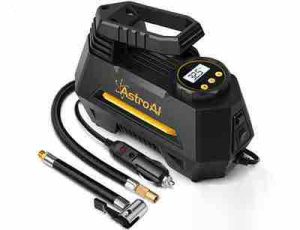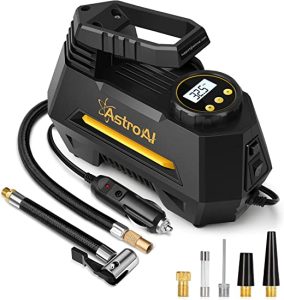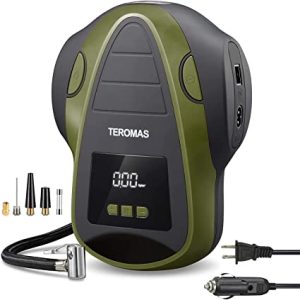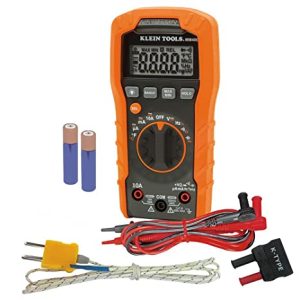If you are new to this, you may not even know what an air compressor is and its capabilities. An air compressor is basically an air inflator.
You can use it to inflate flat tire with the pressurized air that the air compressor has converted from electric energy.
Now to answer your question, Will a 3 gallon Air Compressor Fill a Car Tire? Yes, a 3-gallon air compressor can fill a car tire. A 3-gallon air compressor can give up to 100 PSI.
You should also know that a 3-gallon air compressor is most suited for cars with smaller tires, like the Sedans and smaller SUVs that require around 32 to 35 PSI.
Vehicles like trucks and trailers can not do with a 3-gallon air compressor.
One thing to note is the PSI of your car tire. PSI is the acronym for pounds per square inch and it is the unit measurement of air pressure that goes into your car tire.
The range of PSI for most cars (recommended for passenger cars) is 32 to 35 for a tire.
That means if you have two flat tires and each has a PSI of say 34, multiplied by 2, we have 68 PSI. Your 3-gallon air compressor can inflate both with a little leftover for yet another. Great isn’t it?
Be sure to check the PSI regularly because it changes over a few weeks and in different temperatures. What’s that? How do you know the PSI of your car tires?
Most cars today come with it on the user’s manual or with a sticker on the door. If you don’t see the sticker, or you got it second-hand, see a good mechanic.
Table of Contents
How to air up tire with a gallon air compressor

These easy steps not only teach you how to use an air compressor but will get you back on the road.
- Step 1: Get all tools ready
- Step 2: Get your tire PSI
- Step 3: Measure the air pressure
- Step 4: Inflate the tire
- Step 5: Finish up
Step 1: Get all tools ready
For this, you will need only two things: an air compressor and a tire pressure gauge.
Any of these two are easy to find. You should be able to get them anywhere auto parts and all are sold but real quick I will recommend good ones for you.
For your air compressor, I will recommend Slime (See here on Amazon). It is rechargeable, portable, and comes with a pressure gauge. It is also multi-purposed.
You can also get AstroAI Air Compressor Tire Inflator (See here on Amazon). It is just as effective as slime and they both have 100 PSI.
For your tire pressure gauge, Tru-flate is ideal.
You can also get a pair of gloves, for safety and hygiene sake. That is optional.
Step 2: Get your tire PSI
As I said earlier, it is very important to know your tire’s PSI. An overinflated tire will lead to problems controlling or even handling the car. That could lead to an accident. We don’t want that.
An underinflated tire can increase the wearing of the tire and you can damage the tire altogether. We don’t want that either.
Seeing how crucial it is please be sure you get the PSI for both the front and back tires. They differ so don’t make all of them the same.
The picture is an example of a car tire’s PSI and it was found on the side of the driver’s door.
Step 3: Measure the air pressure
Every tire has a stem or valve cap. This little thing right here. You will have to unscrew it and keep it in a safe place. Losing that is having a flat tire till you buy one.
When you unscrew the cap you may hear some hissing noises. It is nothing to worry about. It is just the Then take your tire pressure gauge and gently stick it into the stem.
Read what the gauge says. Let’s say your car tire needs 34 like the car above and your gauge says 22, you will have to fill it with the difference. If you add 12 to it, you will have 34 so you only need 12 psi added.
Step 4: Inflate the tire
Don’t sweat, you are almost done. Now you will have to consider a few things here.
Quick tip, it is best to fill your tires on a cold day because heat affects pressure and it will give you a more accurate reading in a cold temperature.
The first is the type of outlet you are using for the compressor. If you use one that is lower than the voltage of the air compressor, you stand a chance of… spoiling the outlet or the compressor.
If you are lucky, maybe both! Next, you have some very simple rules to follow. Try to get the compressor as close to the car as you possibly can.
Next, don’t ever turn on the compressor switch without turning it on. Now let’s continue.
Get the hose and put it into the tire valve. Some come with a nozzle lock so it secures it.
Make sure you secure it before you flip on the switch or turn on the compressor.
When it starts, you can read from the gauge on the compressor or wait a while to check with your tire pressure gauge.
After a while check how much air pressure is in it by using the tire pressure gauge. If it has exceeded the tire’s PSI, gently push down on any part of the tire to get some of it out.
Step 5: Finish up
All you have to do is make sure that the amount of air pressure in your tire matches your tire’s PSI.
When turning off the air compressor please turn off the compressor switch first before the power switch.
After that, screw the cap on tightly and you can now take off your gloves. Your tire is ready!
How many gallons of air to fill a tire?
If a tire has a capacity of 200 cubic inches, you can convert it to gallons by dividing by 231 (since there are 231 cubic inches in a gallon). In this case, the tire would require approximately 0.87 gallons of air to fill it to the recommended pressure.
In other words, the amount of air needed to fill a car tire can vary depending on the size and type of the tire.
Most car tires have a recommended pressure, usually measured in pounds per square inch (PSI), which can be found in the vehicle’s manual or on a sticker located on the driver’s side door jamb or inside the fuel filler flap.
To determine the volume of air required, you need to know the tire’s capacity, measured in cubic inches, and convert it to gallons.
What to consider when buying air compressors for car tires
There are a few factors you have to take into consideration unless you will find out you have wasted your money and you will have to take it out with return policies.
- Air pressure
- Horsepower rating
- Duty Cycle
Air pressure or the PSI

We have touched this all through the article and I have explained the importance of well-pumped tires. They are also crucial for your safety.
Let’s imagine you have a truck and its PSI is 42. If you have three flats in a day (worst possible scenario), an air compressor that gives only 100 PSI won’t do the trick.
You will have to find heavy-duty air compressors, appropriate for your vehicle. Okay, what if it is just two tires, huh? Won’t a 100 PSI air compressor be good enough? Not really.
The PSI of the air compressor is its capability. We are not talking about restrictions the pressure builds and finds its way to the tire, the couplers that hold it firmly in place, the nozzle, and even the hose may be restrictions, reducing the amount of pressure.
That’s why you have to up your game.
Horsepower rating

It’s very important. If a compressor has a 5-star rating then it is really good. You should be careful though, as most sellers hype the ratings of the compressor.
The best thing to do is to go for industrial compressors that are closer to the truth. They are also more efficient because of the reason they are built.
While a normal compressor can run 15 amps on a 110-volt circuit, an industrial compressor runs 24 amps on a 220-volt circuit.
If you convert the normal compressor to the energy of the industrial compressor, you won’t have up to 3 real HP. Sad isn’t it?
Duty cycle

The duty cycle is how long a compressor can run within a given time, usually 10 minutes. It is invariably the strength of the compressor and it is measured in percentage.
If your compressor has a 50% duty cycle it means it can run 5 minutes out of 10 before you turn it off.
If you keep it running, you will destroy the compressor. As always, industrial compressors have up to 75% sometimes, 100% duty cycle.
Does the tank size matter when buying an air compressor?
The truth is the tank size is not that big a deal. If your air compressor has a good duty strength, pump, and motor, you have all you need in a compressor.
A big tank size will only be a plus because it will help store more air, not produce it. Tank size can only really matter if you are trying to be economical.
Then you will get a small compressor with a big tank. The tank will store and while you turn it off according to its duty strength, you can use what you have stored.
Conclusion
Okay. That’s a wrap. I hope you can compress all this and get in. I am sure you have learned a thing or two not just about tires but compressors in general.
You can leave your questions and comments in the comment section below and I will see you in the next article.


Great content